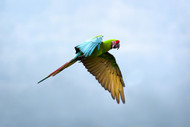Thinking On The Wing Part 1
Posted by Who do Parrots need to fly, benefits of Parrots flying, Parrots and flight on 24/1/2024
At the first hint of danger a bird normally takes to flight. During the hundreds of defensive short flights which flighted birds take each day, they are quickly assessing potential dangers and deciding if they need to keep flying to avoid a real danger.
These short flights require immediate and appropriate decision making abilities. The process is called ?Thinking on the Wing?.
The Parrot University spent 20 years researching what makes a Parrot a ?Parrot? We have found that the number one characteristic that defines ?a Parrot? is its ability to fly. Flight is fundamental to every component of a Parrot?s mind and body.
Learning to fly well is the most complicated and important task a Parrot can learn. Flighted Parrots are healthier, more active, more coordinated, and have much better vision. Flying promotes higher intelligence, self-confidence, self-esteem ? and ultimately makes a more social long-term companion.
Can a Parrot, designed by nature for millions of years, be truly mentally and physically healthy without flight?

Serious preparation for flight for the average Parrot begins at about three or four weeks old.
Neuropathway development in the coordination centre (cerebellum) of the very young Parrot is the first step in preparation for flight. This process begins the first time the baby starts to move around in the nest and is substantially complete by six months. Every new type of physical activity programs more neuropathways in the cerebellum.
The cerebellum, which is at the bottom of the back of the brain, stores the program for coordination, and ultimately supplies motor skills for flight. Neuropathways are the brain?s electrical connections that allow information to be transferred throughout the body.
Since more experiences and activities lead to better motor coordination by creating more neuropathways, it makes sense that learning to fly adds an incredible number of neuropathways in the cerebellum.
Babies
Babies learn best when multiple senses are stimulated simultaneously (ie sight, sound, taste, touch and smell). The best opportunity for a Parrot to learn is when a combination of senses is experienced at the same time. The senses of sight, sound and touch take on a very different nature during flight. Flying offers a greater variety of situations that Parrots need to utilize for optimal mental and eventual social development.
The Parrot brain develops on a pre-determined schedule that has been ?finely-tuned? by evolution for millions of years. Each one of the senses, as well as mental and physical skills, develops over a period of time, but not at the same time. Some of the development phases are symbiotic, meaning they need information being developed in another area of the brain for their own optimal development.
For example, vision develops best when the baby can move around and see things from different angles and distances. Conversely, coordination develops best when the visual cortex can provide information on distance and perspective. Without this symbiotic relationship of vision and coordination, it is difficult to develop three-dimensional vision.
Two very important brain functions required for flight are coordination and vision.
Coordination and vision develop in different parts of the brain, but are essential for the other?s optimal development and critical for flight skills.
Coordination develops in the cerebellum at the back of the brain as the baby moves around and repeatedly tries new and progressively more complicated activities. The Parrot?s visual cortex, which is quite different from ours, connects with virtually every part of the avian brain.
A baby?s vision, at hatching, is a jumble of blurred shades, shapes and movements. The baby has the basic program to recognize these light rays entering his eyes, but needs to learn how to interpret the basic images so they can be directed to the appropriate part of the brain for interpretation.
Motor skills and vision are in some ways so integral to each other that it is difficult to separate the two. As a baby flies towards a tree, he will begin to associate the visual changes with the closing of the distance between him and the object.
As his motor skills develop, he will begin to anticipate an impending crash and learn how to slow down. The faster he flies, the faster the visual ability needs to be and the faster the brain learns to process the information, and the faster he will be able to fly.
Teaching the brain to process information faster and on higher levels, promotes faster decision-making and fewer mistakes in all areas of mental, physical and social competence. This combination of skills is significantly more important in Parrots since they are a prey species, and constantly need to be ready to ?think on the wing?.

Compensating Networks
Now that we understand how important symbiotic neuropathway development is, we can look at how other areas of development and personality are affected when normal brain development is interrupted.
When the brain is not able to process information fast enough, it creates ?compensating, networks?. Compensating networks develop in order to make quick decisions when education and experience are not sufficient to quickly produce an educated decision.
Basically, when a situation calls for a quick decision, there are usually several variables that need to be considered. Highly functioning individuals quickly analyze every variable and make an educated decision. Lower functioning individuals often use compensating networks to jump to conclusions to avoid the problem. This often occurs for two reasons: the bird wants to bypass frustration, or, for defense reasons does not have the time to work on the problem.
Low functioning individuals that are unable to ?think on the wing? often use compensating networks. One of the most common is the ?bite first ask later? ?compensating maneuver?.
?
Watch out for Part 2 where I will cover the six main areas where flight is important to a Parrot.
Teach your Parrot to fly safely with a harness.

